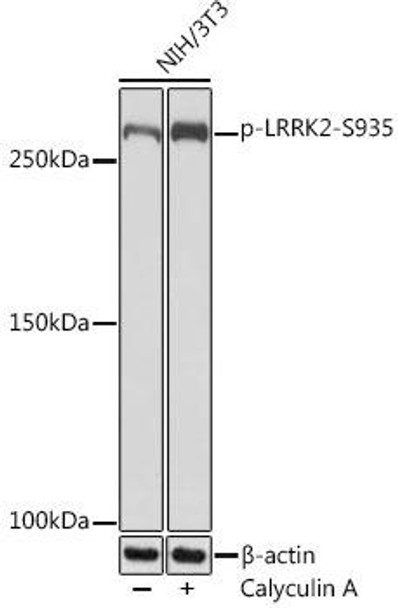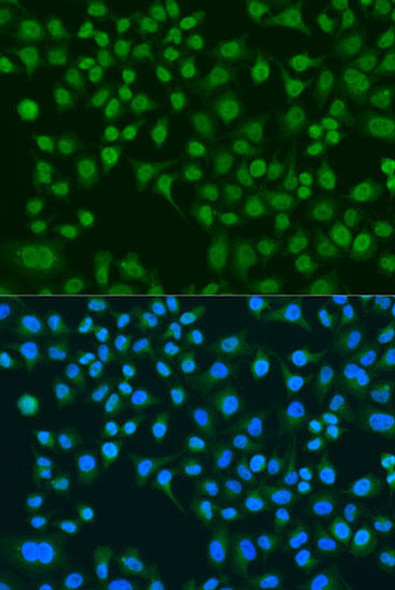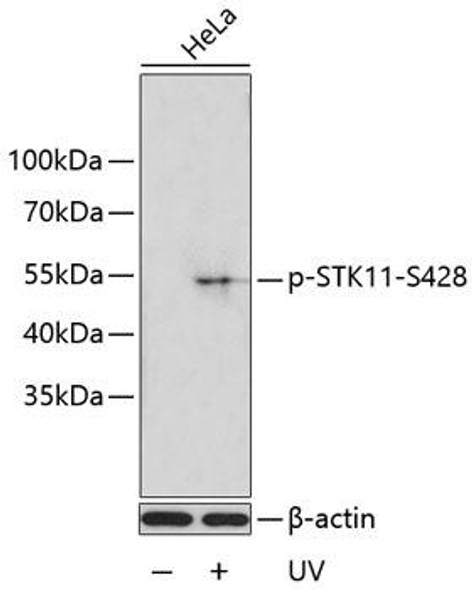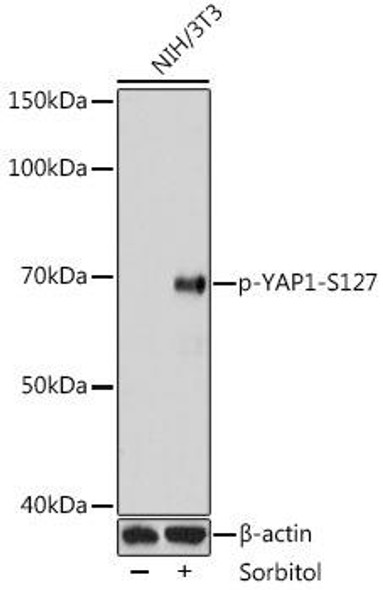Description
Anti-Phospho-LRRK2-S935 Antibody (CABP1154)
The Anti-Phospho-LRRK2 (S935) Antibody (CABP1154) is a cutting-edge tool for research involving LRRK2, a protein associated with Parkinson's disease and other neurodegenerative disorders. This antibody, produced in rabbits, exhibits high specificity for detecting phosphorylated LRRK2 at serine 935 in human samples and is validated for use in various applications, including Western blotting.LRRK2 is a key player in regulating cell processes related to neuronal health and function, making it a critical target for studying neurodegenerative diseases. Phosphorylation at serine 935 has been linked to LRRK2 activity and dysfunction, making this antibody invaluable for understanding the mechanisms underlying Parkinson's disease and potentially identifying new therapeutic targets.
By enabling precise detection and analysis of phosphorylated LRRK2, the Anti-Phospho-LRRK2 (S935) Antibody (CABP1154) facilitates research into the pathogenesis of neurodegenerative disorders and the development of targeted treatments to combat these devastating conditions. Its reliability and specificity make it an essential tool for advancing our knowledge of LRRK2 biology and ultimately improving patient outcomes.
| Product Name: | Phospho-LRRK2-S935 Rabbit mAb |
| Product Code: | CABP1154 |
| Size: | 20uL, 50uL, 100uL |
| Synonyms: | AURA17, DARDARIN, PARK8, RIPK7, ROCO2 |
| Applications: | WB |
| Reactivity: | Human, Mouse, Rat |
| Host Species: | Rabbit |
| Immunogen: | A phospho specific peptide corresponding to residues surrounding S935 of human LRRK2 |
| Applications: | WB |
| Recommended Dilutions: | WB 1:500 - 1:2000 |
| Reactivity: | Human, Mouse, Rat |
| Positive Samples: | NIH/3T3, C6 |
| Immunogen: | A phospho specific peptide corresponding to residues surrounding S935 of human LRRK2 |
| Purification Method: | Affinity purification |
| Storage: | Store at -20°C. Avoid freeze / thaw cycles. Buffer: PBS with 0.02% sodium azide, 0.05% BSA, 50% glycerol, pH7.3. |
| Isotype: | IgG |
| Sequence: | Email for sequence |
| Gene ID: | 120892 |
| Uniprot: | Q5S007 |
| Cellular Location: | Cell projection, Cytoplasm, Cytoplasmic side, Cytoplasmic vesicle, Endoplasmic reticulum, Endosome, Golgi apparatus, Lysosome, Membrane, Mitochondrion, Mitochondrion inner membrane, Mitochondrion matrix, Mitochondrion outer membrane, Perikaryon, Peripheral membrane protein, axon, dendrite, secretory vesicle, synaptic vesicle membrane |
| Calculated MW: | 286kDa |
| Observed MW: | 286kDa |
| UniProt Protein Function: | LRRK2: a large multidomain protein kinase with a TKL-type kinase domain, multiple protein-protein interaction domains and a mitochondrial Rho domain (MIRO). May play a role in the etiology of Parkinson disease. May also have GTPase activity. Positively regulates autophagy through a calcium-dependent activation of the CaMKK/AMPK signaling pathway. The process involves activation of nicotinic acid adenine dinucleotide phosphate (NAADP) receptors, increase in lysosomal pH, and calcium release from lysosomes. Interacts with PARK2, PRDX3 and TPCN2. Expressed throughout the adult brain, but at a lower level than in heart and liver. Expressed in the cerebellum, cerebral cortex, medulla, spinal cord occipital pole, frontal lobe, temporal lobe and putamen. Expression is particularly high in brain dopaminoceptive areas. Defects in LRRK2 are the cause of Parkinson disease type 8 (PARK8). A slowly progressive neurodegenerative disorder characterized by bradykinesia, rigidity, resting tremor, postural instability, neuronal loss in the substantia nigra, and the presence of neurofibrillary MAPT (tau)-positive and Lewy bodies in some patients. |
| UniProt Protein Details: | Protein type:Protein kinase, TKL; Kinase, protein; Protein kinase, Ser/Thr (non-receptor); EC 2.7.11.1; TKL group; LRRK family Chromosomal Location of Human Ortholog: 12q12 Cellular Component: axon; caveola; cell junction; cell soma; cytoplasm; cytoplasmic vesicle; cytosol; dendrite; dendrite cytoplasm; endoplasmic reticulum; endosome; extracellular space; Golgi apparatus; Golgi-associated vesicle; growth cone; inclusion body; intracellular; lysosome; microvillus; mitochondrial inner membrane; mitochondrial matrix; mitochondrial membrane; mitochondrial outer membrane; mitochondrion; neuron projection; perikaryon; plasma membrane; ribonucleoprotein complex; synaptic vesicle membrane; terminal button; trans-Golgi network Molecular Function:actin binding; ATP binding; clathrin binding; glycoprotein binding; GTP binding; GTP-dependent protein kinase activity; GTPase activator activity; GTPase activity; identical protein binding; kinase activity; MAP kinase kinase activity; microtubule binding; protein binding; protein homodimerization activity; protein kinase A binding; protein kinase activity; protein serine/threonine kinase activity; receptor signaling complex scaffold activity; Rho GTPase binding; SNARE binding; syntaxin-1 binding; tubulin binding Biological Process: activation of MAPK activity; activation of MAPKK activity; autophagy; calcium-mediated signaling; cellular response to starvation; determination of adult life span; endocytosis; Golgi organization and biogenesis; GTP metabolic process; intracellular distribution of mitochondria; lysosome organization and biogenesis; MAPKKK cascade; mitochondrion localization; mitochondrion organization and biogenesis; negative regulation of macroautophagy; negative regulation of protein amino acid phosphorylation; negative regulation of protein binding; neurite morphogenesis; neuromuscular junction development; olfactory bulb development; peptidyl-serine phosphorylation; peptidyl-threonine phosphorylation; phosphorylation; positive regulation of autophagy; positive regulation of dopamine receptor signaling pathway; positive regulation of GTPase activity; positive regulation of MAP kinase activity; positive regulation of programmed cell death; positive regulation of proteasomal ubiquitin-dependent protein catabolic process; positive regulation of protein amino acid phosphorylation; positive regulation of protein binding; positive regulation of protein ubiquitination; protein amino acid autophosphorylation; protein amino acid phosphorylation; regulation of autophagy; regulation of dopamine receptor signaling pathway; regulation of excitatory postsynaptic membrane potential; regulation of locomotion; regulation of membrane potential; regulation of mitochondrial depolarization; regulation of neuron maturation; regulation of synaptic transmission, glutamatergic; response to oxidative stress; small GTPase mediated signal transduction; tangential migration from the subventricular zone to the olfactory bulb; Wnt receptor signaling pathway through beta-catenin Disease: Parkinson Disease 8, Autosomal Dominant |
| NCBI Summary: | This gene is a member of the leucine-rich repeat kinase family and encodes a protein with an ankryin repeat region, a leucine-rich repeat (LRR) domain, a kinase domain, a DFG-like motif, a RAS domain, a GTPase domain, a MLK-like domain, and a WD40 domain. The protein is present largely in the cytoplasm but also associates with the mitochondrial outer membrane. Mutations in this gene have been associated with Parkinson disease-8. [provided by RefSeq, Jul 2008] |
| UniProt Code: | Q5S007 |
| NCBI GenInfo Identifier: | 294862450 |
| NCBI Gene ID: | 120892 |
| NCBI Accession: | Q5S007.2 |
| UniProt Secondary Accession: | Q5S007,Q6ZS50, Q8NCX9, A6NJU2, |
| UniProt Related Accession: | Q5S007 |
| Molecular Weight: | 286,103 Da |
| NCBI Full Name: | Leucine-rich repeat serine/threonine-protein kinase 2 |
| NCBI Synonym Full Names: | leucine-rich repeat kinase 2 |
| NCBI Official Symbol: | LRRK2 |
| NCBI Official Synonym Symbols: | PARK8; RIPK7; ROCO2; AURA17; DARDARIN |
| NCBI Protein Information: | leucine-rich repeat serine/threonine-protein kinase 2 |
| UniProt Protein Name: | Leucine-rich repeat serine/threonine-protein kinase 2 |
| UniProt Synonym Protein Names: | Dardarin |
| Protein Family: | Leucine-rich repeat serine/threonine-protein kinase |
| UniProt Gene Name: | LRRK2 |
| UniProt Entry Name: | LRRK2_HUMAN |










